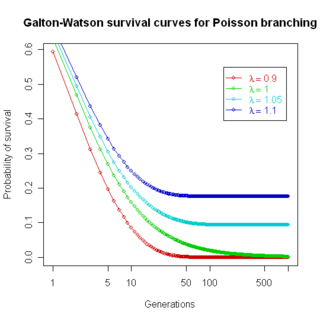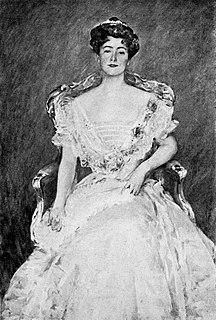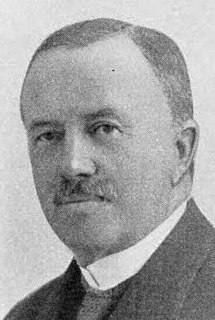
Anthropology is the scientific study of humanity, concerned with human behavior, human biology, cultures, societies, and linguistics, in both the present and past, including past human species. Social anthropology studies patterns of behaviour, while cultural anthropology studies cultural meaning, including norms and values. A portmanteau sociocultural anthropology is commonly used today. Linguistic anthropology studies how language influences social life. Biological or physical anthropology studies the biological development of humans.

The Galton–Watson process is a branching stochastic process arising from Francis Galton's statistical investigation of the extinction of family names. The process models family names as patrilineal, while offspring are randomly either male or female, and names become extinct if the family name line dies out. This is an accurate description of Y chromosome transmission in genetics, and the model is thus useful for understanding human Y-chromosome DNA haplogroups. Likewise, since mitochondria are inherited only on the maternal line, the same mathematical formulation describes transmission of mitochondria. The formula is of limited usefulness in understanding actual family name distributions, since in practice family names change for many other reasons, and dying out of name line is only one factor.

John Reed Swanton was an American anthropologist, folklorist, and linguist who worked with Native American peoples throughout the United States. Swanton achieved recognition in the fields of ethnology and ethnohistory. He is particularly noted for his work with indigenous peoples of the Southeast and Pacific Northwest.

Charles Gabriel Seligman FRS FRAI was a British physician and ethnologist. His main ethnographic work described the culture of the Vedda people of Sri Lanka and the Shilluk people of the Sudan. He was a Professor at London School of Economics and was highly influential as the teacher of such notable anthropologists as Bronisław Malinowski, E. E. Evans-Pritchard and Meyer Fortes all of whose work overshadowed his own.

Caroline Augusta Furness Jayne was an American ethnologist who published the first book on string figures in 1906 titled String Figures: A Study of Cat's Cradle in Many Lands.

The Royal Anthropological Institute of Great Britain and Ireland (RAI) is a long-established anthropological organisation, and Learned Society, with a global membership. Its remit includes all the component fields of anthropology, such as biological anthropology, evolutionary anthropology, social anthropology, cultural anthropology, visual anthropology and medical anthropology, as well as sub-specialisms within these, and interests shared with neighbouring disciplines such as human genetics, archaeology and linguistics. It seeks to combine a tradition of scholarship with services to anthropologists, including students.
The Tataviam are a Native American group in Southern California. Their tribal government is based in San Fernando, CA, and includes the Executive Branch, Legislative Branch, Tribal Senate, and the Council of Elders. The current Tribal President of the Tatavian people is Rudy Ortega Jr.

Ramaprasad Chanda was an Indian anthropologist, historian and archaeologist from Bengal. A pioneer in his field in South Asia, Chanda's lasting legacy is the Varendra Research Museum, he established in Rajshahi, a leading institute for research on the history of Bengal.He was the first head of the Department of Anthropology at the University of Calcutta from 1920- 1921.He was also a professional archaeologist and worked in the Archaeological Survey of India. Chanda was one of the founders the Indian Anthropological Institute and was its president during 1938–1942. He represented India in the first International Congress of Anthropology held in London in 1934.He had done original research on the somatic characters of Indian populations by using ancient Indian literature and challenged H.H.Risley's theory on Indian races.

John Beddoe FRS FRAI was one of the most prominent English ethnologists in Victorian Britain.

The Boston University School of Medicine (BUSM) is one of the graduate schools of Boston University. Founded in 1848, the medical school was the first institution in the world to formally educate female physicians. Originally known as the New England Female Medical College, it was subsequently renamed BUSM in 1873. In 1864, it became the first medical school in the United States to award an M.D. degree to an African-American woman.

Ernest Chantre was a prominent French archaeologist and anthropologist.
The Swedish Society for Anthropology and Geography is a scientific learned society founded in December 1877. It was established after a rearrangement of various sections of the Anthropological Society, which was formed in 1873 by Hjalmar Stolpe, Hans Hildebrand, Oscar Montelius, and Gustaf Retzius.

Halfdan Bryn was a Norwegian physician and physical anthropologist.
Mro-Khimi is a Kuki-Chin language of Burma spoken by the Mro-Khimi people.
The Gunggari, or Kunggari, are an Aboriginal Australian people of southern Queensland. They are to be distinguished from the Kuungkari.
The Baruŋgam are an Aboriginal Australian people of Southeast Queensland.
The Kambuwal were an indigenous Australian people of the state of Queensland.
The Kokowara were an indigenous Australian people of the state of Queensland.
The Nguri were an indigenous Australian people of the state of Queensland.
The Kula, also known as the Kurnu, were an indigenous Australian people of the state of New South Wales.